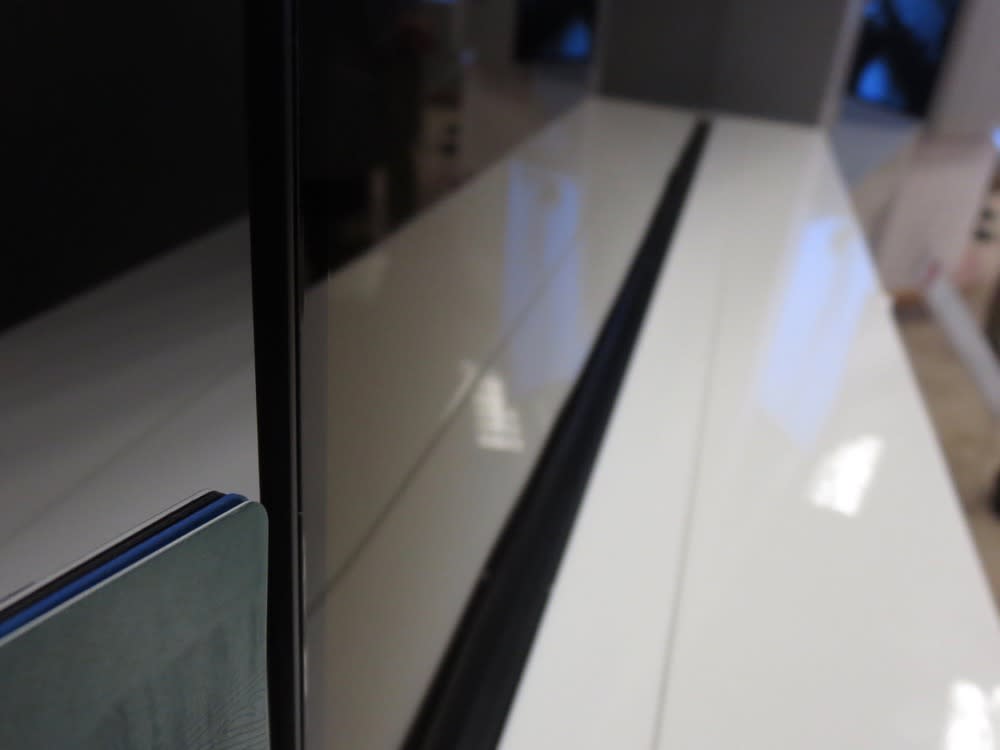LG’s See-Through, Rollable OLED Screens: Here, But Not Cheap (Yet)

(Photos by Rob Pegoraro/Yahoo Tech)
Ultra-thin, incredibly light and exceptionally bright displays based on organic light-emitting diode (OLED) technology have come a long way — getting both bigger and more common — since the technology made its U.S. debut at the 2008 CES, in the form of an 11-inch, Sony HDTV that cost $2,500.
OLED screens are now found in everything from phones to 70-inch displays and beyond, but they still face some challenges. Compared to the LCD (liquid crystal display) screens that dominate the market, OLEDs aren’t cheap. And those LCDs have continued to get thinner while also making dramatic improvements in picture quality.
Related: More coverage of CES 2016.
At this year’s CES, LG — one of the leading manufacturers of OLED TVs — decided to show that there’s more to the technology than just making flat-panel screens flatter and brighter. (Though it must be pointed out that one of LG’s new models is no thicker than four credit cards.) The Korean conglomerate’s displays unit invited a small group of journalists and analysts to take a peek at the next generation of OLED screens.
The first of these OLED oddities (above) seemed normal enough as it rotated below an overhead mount — until you noticed that it had a second screen on its back. The idea with this two-faced TV is not to provide some sort of commentary on America’s addiction to video, but to allow businesses to set up displays that people on both sides of a room could see.

Next came two radically curved displays, one concave and one convex; in the middle of the room, a group of these had been assembled into an serpentine wall of video. This, we were told, could have uses in public settings — we’re told there’s a tunnel in Seoul lined with these displays — and in stores (presumably the kind in which I can’t afford to buy anything).

After that we saw an OLED screen you could turn mostly transparent. Why bother? You could have the TV show off your wallpaper when you’t not watching it instead of being a black rectangle, or you could stick a transparent screen on a window.
(In the here and now, Mashable’s Lance Ulanoff found a use I wish I’d thought of first: He took a selfie through the TV.)

Finally, LG showed off what at first looked like some sort of ear trumpet (below) — except this cone-shaped thing was another screen. Then a white-gloved rep demonstrated how you could take one of these screens and roll it up as it were thick, glossy paper that happened to be playing video.
Rollable screens aren’t new — I saw an e-ink version of one from Philips in 2002 — but I haven’t seen one as big as this 18-inch prototype.

As a demo of technical excellence, this tour was impressive —most impressive. But OLED’s problem has never been the technology itself, but its price. Two of the screens LG revealed in this year’s lineup illustrate the problem: A 65-inch, top-of-the-line Ultra HD LCD screen will sell for $4,000, while an OLED screen of the same size and resolution will cost $7,000.
LG’s message on that: Give us time. K.J. Kim, a vice president at LG Displays, said it took the company a few years to get its yield rates (the share of produced panels that meet specifications) on mere high-definition OLEDs up to 80 percent, and it’s now climbing the same hill with Ultra HD screens but at a faster rate.
“By the end of this year… the yield issue will be pretty much gone,” Kim said. He also said the price premium should shrink, at the smaller end of UHD screen sizes first: “Probably by 2018, the mainstream 55-inch area will go below the $2,000 range.”
But in those three years, LCDs could continue their own steady evolution that earlier saw them displace plasma displays, which had their own picture-quality advantages but couldn’t get as cheap as quickly as LCD could.
And OLED manufacturers still have to address longevity issues. Kim’s estimate that OLED screens will be good for 30,000 hours of viewing before they’ve lost half their original brightness sounds like a lot — but LED-backlit LCDs can last far longer.
OLED looked like great technology in Wednesday’s demo, but “good enough” is a powerful argument in consumer tech. That shouldn’t stop OLED from securing a profitable, high-end niche. But it may suffice to keep it out of your own living room.
Email Rob at rob@robpegoraro.com; follow him on Twitter at @robpegoraro.
More from CES 2016:
HTC and UnderArmor’s HealthBox is an All-in-One Fitness Tracking System
HTC Debuts Improved Vive Pre VR Headset with Front-facing Camera
Samsung Goes After Microsoft, Apple With Win 10 Tablet and Laptops
Toyota Spending $1 Billion to Develop AI-Driven Cars, Robots for the Home
Ford Says It Will Have Self-Driving Cars and Smart-Home Integration by 2020
4 Big Trends at CES 2016: Cars, Wearables, Laptops, and Accessories for Everything
Meet CleverPet, the Electronic Game That’s Like ‘Simon’ For Dogs


